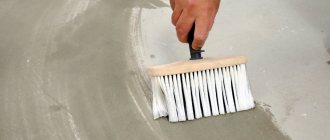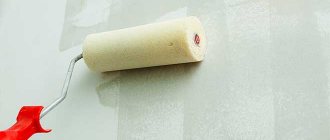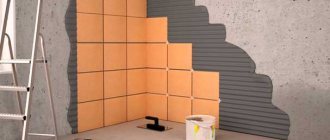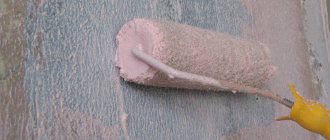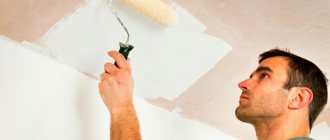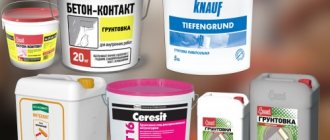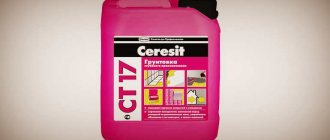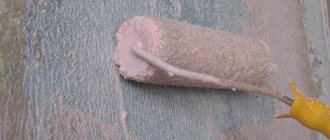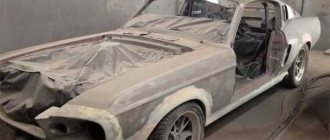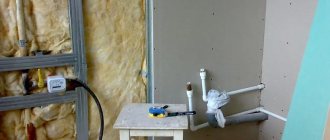The surface of concrete products, houses, buildings and other structures, due to its porous structure, is “affected” by precipitation. Rain or melt water penetrates the pores of the surface. At sub-zero temperatures it freezes and, according to the law of physics, expands in volume and literally “tears” the surface into small pieces.
Every year the affected areas increase in size. Concrete primer successfully solves the issue of effectively protecting the concrete surface for many years. In addition, the appropriate type of material is used to improve the adhesion of finishing materials to the concrete base and for other purposes.
Table of contents
- Should concrete be primed before painting?
- Preparing concrete for painting: cleaning methods
- Strengthening concrete before priming
- Types of primers for concrete
- Conclusion
Choosing the optimal solution
Various groups of primers are widely used. When choosing, you should take into account the compatibility of the materials that will be used in the construction of intermediate and finishing layers. If the surface is used under special conditions, a special primer should be used.
The functionality of the main ones is as follows:
- reinforcing – designed for work on plastered surfaces, which are characterized by an unstable, loose structure with a large number of micropores;
- deep penetration primers - this solution is relevant for weak bases;
- anti-corrosion - similar compounds work on reinforced concrete. Anti-corrosion properties will have a good effect on the protection of reinforcement;
- compositions with increased adhesion - soil is in demand on concrete with an increased amount of contaminants of inorganic and organic origin;
- universal - materials of this type work on concrete, reinforced concrete, and loose surfaces.
Primers for exterior use are divided according to the type of binder into alkyd , latex , acrylic , polystyrene , polyurethane , phenolic, etc.
Should concrete be primed before painting?
Priming is an important first step when painting concrete or any other brick product. The primer allows the paint to adhere well to the surface and also allows for an even application without compromising the color. This allows the paint to last longer, look better, and become chip-resistant. It is also a great savings because once the primer is applied, fewer coats of paint are required to create the final coat. Primer will extend the life of your concrete by absorbing into the fine pores that turn a rough surface into a smooth one.
Generally speaking, priming concrete before painting is so necessary that it makes no sense to begin finishing without pre-treatment. Why? Let's answer.
Why does concrete need a primer before painting?
Concrete can produce efflorescence, a white powder that can come out of concrete and other building materials.
The technical definition of efflorescence is “a crystalline precipitate of salts that can form when water is present in concrete.” Concrete has small pores that allow water to seep in from the soil below or in from the outside. Even smooth concrete has tiny pores through which moisture can penetrate.
Along with this water comes minerals and concrete residues that cause efflorescence. Water and weather conditions can affect the amount of efflorescence that concrete produces.
Fading makes it difficult for paint to adhere to the concrete surface. It can also cause paint to rot and crack if you don't use a primer, which fills fine pores and helps prevent efflorescence.
The primer fills in any small holes where dirt or efflorescence may have settled. It soaks into the concrete, which also helps prevent mold and mildew from forming due to moisture. This is why you should always prime your concrete before painting.
The primer creates an extra layer on top of the concrete that sits between the paint and the concrete.
For both exterior and interior applications, applying a primer to the concrete prepares the surface for painting. This produces several important and useful results:
- The primer fills any small gaps or pores, creating a smooth, uniform surface ready for painting.
- It acts as a binder between concrete and paint. This ensures proper adhesion to both surfaces.
- The primer soaks into the cement, which helps protect it from damage over time.
- A primer extends the life of the paint or stain.
- Primer turns a paint-bad surface into a smoother one that accepts paint.
- A finished painted wall looks much better with a primer.
Return to contents
Why is it important to treat the concrete surface with soil?
Many people mistakenly believe that protecting a concrete foundation is not necessary.
However, despite the fact that concrete itself is a very durable material with a long service life, it is also susceptible to various aggressive environments and loads.
- Water entering through the pores, freezing, can lead to delamination of the material and the appearance of microcracks.
- The reinforcement present in the concrete body begins to rust under the influence of water, gas, and salts, which also gradually leads to destruction.
Destruction of concrete from corrosion
- If we talk about concrete floors, then the top layer of the base is quite fragile, during operation it begins to deteriorate, dust appears, which harms human health and worsens the characteristics of the floor.
What does priming a concrete surface provide:
- The soil binds dust particles and the surface is dust-free.
- A primer for concrete surfaces protects the base from the formation of fungus and mold.
- With the help of such compositions, the adhesion of a smooth concrete base to subsequently applied coatings is improved. Otherwise, after finishing work, cracks may appear in the plaster and paint, and the wallpaper may peel off.
- As a result of using a primer, the quality of application is improved and the consumption of liquid and paste finishing materials is reduced.
- Primers close the pores of concrete, thereby protecting it from external influences and increasing its service life.
- The use of soil allows you to strengthen the top layer of concrete and make it more resistant to loads.
Considering the above, we can conclude that treating the floor, walls, ceiling, and other concrete bases with a primer is necessary. Requirements for materials for protecting concrete are set out in GOST 31384-2008 “Protection of concrete and reinforced concrete structures from corrosion.”
Preparing concrete for painting
It is important to clean the concrete before priming or painting. Small pores can hold large amounts of dirt, oil, and debris. All this makes it difficult for paint and primer to stick to the surface. And if you don't clean the concrete first, your primer will lock in all that dirt and oil. Over time, oils can begin to break down the primer and paint from the inside out. So make sure the surface is really clean before priming.
There are several good ways to clean concrete and prepare it for painting.
A pressure washer, concrete cleaner, scraper, scrubbing brush, plain old soap and warm water are all good tools to use when cleaning concrete.
Water Cleaning: Pressure rinses are great for cleaning concrete. Vary the pressure depending on the condition of the concrete. But too powerful a jet of water can easily damage a weak concrete base, so you need to be careful.
Mechanical cleaning: scrub the concrete with a wire brush until the dirt is completely gone. You can scrub most concrete surfaces vigorously unless they are old and brittle.
If there is old paint left on the wall, you can use a scraper to remove it. Try to clean the surface as much as possible from excess. This will give you a smoother painted surface and reduce the likelihood of chipping in the future.
But do not overdo it, as weak concrete may not withstand intensive cleaning and will begin to crumble.
Chemical cleaning: Chemical treatment will allow the solution to penetrate into the concrete base and remove efflorescence from the inside. This method is considered more effective than mechanical cleaning, since the chemical solution removes contaminants not only from the outside, but also from inside the concrete, preventing the reappearance of efflorescence.
When choosing concrete cleaning by chemical treatment, we recommend that you pay attention to the facade cleaners produced by our company, which will protect the concrete base from salt deposits and other atmospheric contaminants.
Return to contents
Strengthening concrete before priming
Always harden the concrete surface before applying primer or paint.
Smooth rough and uneven concrete using an angle grinder. Use a sander and masonry knife to smooth out any uneven surfaces in the concrete. The smoother the surface, the better it will hold paint and primer and the cheaper the job will be. A rough surface will require more primer and paint to ensure an even finish.
In addition to sanding, smoothing and cleaning your concrete, if there are any cracks or crevices, you will need to repair them before priming. Mix repair cement or concrete and fill any large gaps.
Brittle areas should be removed and filled. You don't want your freshly painted concrete to start to deteriorate.
Return to contents
How it works
When carrying out external work, primer compositions are applied before plastering, putty, painting and other layers. The need for impregnation is due to the fact that bases made on the basis of artificial stone actively absorb moisture from the mixtures. In the absence of primer preparation, absorption will be uneven, the finishing layer will not have time to adhere to the surface, which will cause peeling. The soil will prevent this process and increase adhesion.
Materials for external concrete work have additional functionality:
- strengthening the surface layer of structures . Particles of primer mixtures penetrate into the pores of concrete, forming strong bonds after complete hardening. No dust is formed on the surface, mineral materials do not crack or crumble;
- penetrating waterproofing . Deep penetration compositions help clog open pores. Moisture and water from precipitation stops seeping into the thickness of the concrete. Such protection significantly increases the frost resistance and, as a consequence, the durability of the foundations.
Additionally, primers are applied to the plaster layer . As is known, this surface is heterogeneous and is characterized by different densities. This may cause uneven distribution of finishing compounds. The operation will reduce the consumption of materials used.
Types of primers for concrete
There are several different products we use to prime concrete before painting.
Primers are made in three ways: alkyd/oil based, acrylic/latex based and tinted shellac. As a rule, they are intended for both external and internal use. If you're on a budget, you can buy a universal primer that can be used on almost any surface. But if you want a better finish, we recommend purchasing a primer specifically designed for concrete. This material is more expensive, but the result is better.
Primers for concrete:
- Acrylic primers.
Because concrete is porous, a water-based or acrylic-based primer is more likely to soak into the concrete than an oil-based primer. This creates a bond with the substrate, which allows the paint to adhere to the surface a little better. Better grip means less chipping and peeling in the future. Acrylic primers also help reduce dust accumulation on indoor concrete. - Polyurethane primers.
Not only are these products incredibly strong and durable, but they can also withstand chemical and harsh work environments in commercial or industrial work areas. We do not recommend using them in residential areas. - Epoxy primers.
The epoxy mixture is made on a resin basis with the addition of special components to improve the protective properties of the material. This primer withstands temperature changes and moisture, and is also resistant to mechanical stress. As a rule, such a primer is used in industry.The disadvantages include high cost, low drying speed (about 12 hours) and the impossibility of accelerating the drying process by force - this can lead to uneven hardening and the appearance of swelling in the form of bubbles on the surface.
Each of these primers absorbs well into the concrete and is resistant to chipping and other defects. Some are thinner and better suited for indoor use, while some are better suited for outdoor use. For application details, please contact the respective manufacturers.
An excellent choice for treating concrete in domestic conditions will be the acrylic adhesive primer “Concrete-Contact” from our company. It is produced on the basis of aqueous dispersion, and therefore is environmentally friendly and absolutely safe for humans. The antiseptic additives included in the composition will prevent the risk of rot or fungus appearing on the surface.
Some tips
Here are some tips that may be helpful if you have never primed or painted concrete before:
1. Be sure to prime the concrete before painting. The primer provides the perfect surface for paint to adhere to and makes the final product look its best. Everyone is always in a hurry and wants to use 2 in 1 paints, but they are not suitable for concrete. Take your time and apply only the primer coat and then the paint.
2. Apply primer to large areas, but use a brush to get into small cracks and pores that a roller cannot reach.
3. Mix primer and paint thoroughly before application to reduce streaking and ensure even distribution of color and sealant. Make sure your primer is well covered. When finished you should not see any color showing through the primer.
4. When you're ready to paint, be sure to use a good concrete paint. Just because you prime the surface doesn't mean you can use whatever paint you want. Buy paint specifically designed for masonry. This type of paint is thicker and can expand and contract with the concrete over time. If you use standard inelastic paint, the slightest deformation of the base will cause it to crack.
Return to contents
Why is priming necessary?
When starting new construction, it is necessary to first resolve the issues of protecting concrete from the destructive effects of the external environment. Structures made on the basis of artificial stone are defenseless under the influence of precipitation and solar radiation . As a result, surfaces quickly lose their decorative properties, wear out, and peeling and cracks develop prematurely.
To prevent this, it is recommended to use primers for exterior use. Modern materials fully provide additional protection for facades and other concrete structures. The use of primers allows you to reduce the consumption of finishing paints and varnishes and make the coating more durable.
Each primer composition gives the base its own specific set of properties
The main ones include the following:
- increasing the level of adhesion between finishing layers and the base;
- increasing the resistance of the coating to external influences and operational loads. Such characteristics are achieved by filling the pores of concrete, which leads to its compaction and strengthening;
- protection from negative atmospheric factors . The material creates a film on the surface that provides hydrophobic properties.
The choice of material should be based on the type of base. They work on concrete with specialized or universal means.
Tools and equipment
Preliminary surface preparation is carried out using professional equipment. These can be high-pressure apparatuses, concrete finishing machines, milling cutters, shot blasting, sandblasting machines. Additionally, industrial vacuum cleaners and hard metal brushes are used.
To work with primer compositions you will need:
- rollers, brushes . At the priming stage, this tool is the main one. Paint brushes help to better fill in uneven surfaces, but rollers make the job much easier. The optimal width of brushes is from 10 cm, of rollers – 18-20 cm. The fur coat should be made of artificial material;
- air and airless spray guns . Equipment of this type is in demand for large volumes of work. Ensures fast and uniform application of primer mixtures;
- narrow paint brushes – used for processing concrete with complex configurations, corners and other hard-to-reach areas;
- painting trays – the equipment allows you to conveniently collect soil, without excess.
conclusions
Priming concrete bases is an important technological operation on which the durability, strength of the finishing layers and the base itself depend. All work must be carried out with the highest quality and competence. The cost of professional processing of simple bases starts from 300 rubles per square meter . The choice of an effective material should be based on the actual condition and operating characteristics of the structure.
A detailed description of the properties and application of primer for interior concrete work is shown in the video:
Peculiarities
Primer for concrete is necessary for the following reasons:
- It provides protection to the base from mechanical and chemical influences.
- Concrete, due to its porous structure, needs strong impregnation, and soil significantly reduces the impregnating properties of the material by clogging the pores in it.
- Such solutions significantly increase the service life of the surface.
- Deeply penetrating mixtures ensure good adhesion of the base to finishing coatings.
- The soil helps strengthen the concrete.
- Such solutions have an antibacterial effect on the base, thereby reducing the risk of fungal infections.
Note! Also, a primer for concrete is necessary for better waterproofing of floors and walls, so it can be used to perform high-quality finishing of the floor.
Ceresit
The company has been on the market since 1898. Among its developments are adhesives for heated floors and bitumen-based impregnations. Houses using similar impregnations for finishing still exist today. Cement-based waterproofing impregnations have been produced since 1908 to the present day. The relevance of their use is only increasing.
Price – 450 rub.
Interior primers provide nearly double the adhesion of the original materials. Facade primer mixtures are used in construction at the cold pole (in the cities of Oymyakon and Verkhoyansk).
Optimist
Russian manufacturer specializing in the production of acrylic-based primers. They are used in interior and facade decoration. Users note that pre-impregnation with compositions from Optimist helps to fearlessly stick heavy non-woven wallpaper on walls made of brick and other wall materials.
Bolars
The product range is quite wide. When carrying out repair work, professionals try to purchase not only impregnations from Bolars. All types of finishing materials interact perfectly with each other, complementing each other.
The primer composition from Bolars is presented in the form of a colloidal solution with a slightly whitish tint. It is recommended to use it not only for concrete walls. Excellent performance is observed when used for finishing plasterboard sheets. Films up to 0.5 mm thick are formed that hold heavy varnishes and paints, as well as wallpaper and fiberglass.
Cost – 439 rubles.
Tex
Concrete contact mortars are used to repair buildings. Products from Tex are used for preparatory work. Tex putty and primer mixtures have high adhesion. The latest developments are used in production. Therefore, many finishers speak quite warmly about the products.
Professionals note that this material takes a little longer to dry than from other manufacturers. But when wallpapering on drywall without putty, on a primer, conditions are created for deep penetration of adhesive and coloring materials. The wear resistance of the finishing coating is high.

